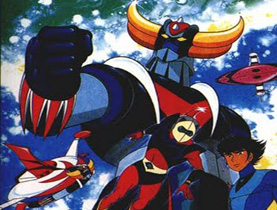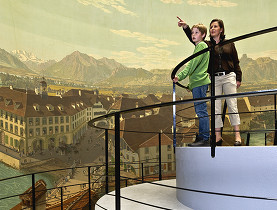Locarno underlines the impact of anime

The hidden depths and traditions of Japanese animation are set for greater public exposure as the Locarno film festival pays tribute to the art form.
Manga Impact, a retrospective of Japan’s comic book and cartoon movement, runs throughout the festival and was the main attraction on Locarno’s Grand Piazza screen on Monday night.
The retrospective is a pet project of the festival’s outgoing artistic director, Frédéric Maire. Two masters of the genre will go home with special awards as part of the festival’s focus on manga anime.
One Leopard of Honour, Locarno’s highest prize, was awarded on Monday to Yoshiyuki Tomino. Tomino is known for having taken robot animation to new levels, endowing them with pathos and a dramatic impact never been seen before.
Earlier in the festival, a Leopard of Honour went to Isao Takahata, a grand master of Japanese animation.
Takahata is renowned for his ability to translate older manga traditions into modernity and for opening up its world of graphic prowess, fantasy, mythology and philosophy.
This iconography, with its strong emotional impact, is partly the key to the success of manga and resulted in its winning over Western youth in the 1970s and 1980s.
Willpower
The 1994 production Pom Poko is Takahata’s expression of how humankind’s destructive behaviour affects the planet. In the film, Japanese racoon dogs, the Tanuki, use powers of metamorphosis to frighten humans into taking better care of the environment. The creatures’ power to transform enables them to communicate with humans.
“They manage to restore direct contact with nature, which is being undermined by modernisation, and serve as intermediaries,” says Takahata, of the film, being shown in Locarno.
“In Japan, animals are on the same level as human beings.”
Man’s relationship with nature and faith in humankind are recurring themes in the genre.
The use of robots in some comics and animation also serves to highlight the importance of feelings and the superiority of human nature. Humans are able to improvise and adapt while the machines are incapable of thinking outside of fixed patterns.
Manga also reflects other aspects of Japanese culture, such as the strength of the community. Typically, American superheroes are characters like Batman and Superman with extraordinary powers, who act alone and use force. Japanese heroes are often vulnerable teenagers who rely on willpower and a sense of responsibility towards ethics and teamwork.
United States film director Quentin Tarantino is among the fans of manga. His fascination is reflected in his recent Kill Bill films, which include animation and stylistic and narrative nods to samurai culture.
Carlo Chatrian, film critic and curator of the Manga Impact retrospective, is a keen follower of the movement.
Impact
“Manga Impact aims to analyse the impact of these kinds of film on people in general and not just film-makers,” he said.
“In some ways, we are the answer. By holding this retrospective, the Locarno film festival and the National Cinema Museum in Turin aim to show that a product of the 1970s that was regarded as primitive and anti-educational at the time, has actually entered our lives in an enduring way.”
For Chatrian, the success of Japanese animation is that it has managed to “clarify seemingly complex topics, like death, pain, loss of parents or nature under threat” for younger audiences and is a way of helping young people adapt in society.
Not all of the actors are endowed with superpowers, but all demonstrate willpower as a force, which allows them to overcome obstacles of life.
Overall, its message is a universal one, adds Chatrian.
“Isao Takahata has clearly said despite strong cultural differences, we are all Japanese, American, French. We are the expression of the same human race. “
Françoise Gehring in Locarno, swissinfo.ch (Adapted from Italian by Jessica Dacey)
Manga is the name for comics, print cartoons and animation in Japanese that have mainly developed since the Second World War. Manga has become a major part of the Japanese publishing industry since the 1950s and have become increasingly popular worldwide.
The Manga Impact project is a collaboration between the Locarno International Film Festival and the National Film Museum in Turin. It aims to show Japanese animation’s impact on Europe (in France, Italy and Spain in particular) in the mid-1970s.
The project comprises a series of events, some of which take place during the film festival, others will be the object of a presentation in Locarno and then developed in more depth at the National Film Museum from September 16.
The retrospective offers around 30 feature films representative of the various strands of Japanese animation starting with The Legend of the White Snake, 1958, the country’s first animated feature to the recent The Sky Crawlers (2008).
There is also a round-up of 20 television series selected for their popularity, their quality and their influence on Japanese animation production, starting with the first Japanese animated series (Astro Boy).
Italian director Maurizio Nicchetti opens Manga Night by presenting a Leopard of Honour award to Japanese animation master Yoshiyuki Tomino.
Mobile Suit Gundam I (1981), a film adaptation of Tomino’s legendary television series, released this year on the 30th anniversary of the original.
La Maison en Petits Cubes (2008) by Kunio Kato, winner of the Oscar for the Best Animated Short Film 2009.
First Squad: the Moment of the Truth (2009) by Yoshiharu Asino, animated film adapted from a 1980s Russian comic strip book called Pioneer Heroes, which fuses Japanese graphic style with the dark and appealing world of its Russian writers.
Akira (1988) directed by Katsuhiro Otomo, in an adaptation of his own eponymous manga: a work that is considered both a landmark in the genre and one of the first to make an impact in the West.

In compliance with the JTI standards
More: SWI swissinfo.ch certified by the Journalism Trust Initiative














You can find an overview of ongoing debates with our journalists here . Please join us!
If you want to start a conversation about a topic raised in this article or want to report factual errors, email us at english@swissinfo.ch.